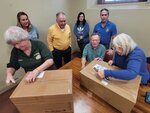
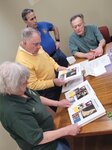
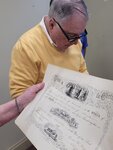
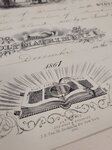
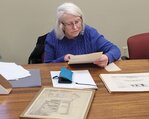
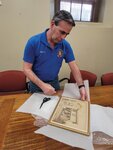
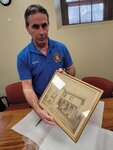
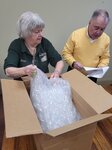
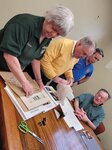
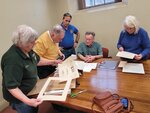
Judge Francis “Frank” X. Flaherty carried a pair of huge sealed cardboard boxes into Warwick City Hall’s subterranean conference room.
Flaherty, a former Warwick Mayor and retired Rhode Island Supreme Court Justice, kept the boxes taped shut for nearly two weeks. Inside, items of historical significance were promised, but their exact nature and provenance remained a mystery until last week.
A little recreational tennis, Flaherty’s old house and the city’s rich industrial past each played a role in the eventual unveiling — the opening of the mysterious boxes Friday morning in City Hall.
Way Back When
The story gets its start back in the early manufacturing days of Rhode Island, after Samuel Slater built the first textile mill on the Blackstone River, spawning more mills along the banks of rivers in cities and villages across the Ocean State.
Apponaug, Natick and Pontiac appeared and swelled like sore blemishes on the banks of the Pawtuxet — mill villages stacked with rows of worker housing, clustered near the pulsating mills. While exploitation of waterways dates back to the region’s earliest civilizations, some visionaries looked inland where the water doesn’t flow directly.
There was an exception and a forerunner to the mills that sprung from centers lacking rivers. Thomas Jefferson Hill recognized and then capitalized on the fact there was a lot of open, easily developable land in Warwick along the recently laid railroad.
Hill built what is believed to be one of Rhode Island’s first stream driven mills, Elizabeth Mill, which he named after his wife. The railroad gave him access to coal and a means to transport goods to market.
A village named Hillsgrove grew up alongside the mill. The name was used for the airport that sprang from the farm fields on Occupasstuxet Road (now Airport Road). Hill’s role in the development of Warwick is recorded in the books of the late Don D’Amato and others, but as Flaherty noted last week, he’s not quite a household name in the city.
Flaherty was reminded of Hill’s enterprises when contacted by Jonathan Farnsworth, a Hill descendent with whom he plays tennis in a Saturday morning league. Farnsworth mistakenly thought Flaherty once lived in a house belonging to Hill. (That wasn’t the case.) It turns out, however, that another descendant to Hill, Miriam Houghton, who lives in California, had contacted him because she had a couple of boxes of Hill memorabilia she felt might be of interest to Warwick historians. The boxes were shipped and received and opened ceremoniously Friday.
Houses For Five Daughters
“He had five daughters,” Flaherty said, referring to Hill. “And as they got married, he built a house for each of them along Apponaug Cove.”
Flaherty named a list of residents he knew who went on to live in the surviving homes. The street was marked with a pair of stone pillars and a gate.
Farnsworth couldn’t have made a better contact than Flaherty, who in addition to his years in public service is a member of the Warwick Historical Cemeteries Commission. Flaherty told Pegee Malcolm, who sprang into action. And he eventually connected with Houghton, who sent him the boxes.
After their arrival, Flaherty assembled an essential appendix of Warwick history buffs — Malcolm, the Chairperson of the Warwick Historical Cemeteries Commission and Rhode Island Historic Cemetery Commission; Felicia Castiglioni Gardella, President of the Warwick Historical Society; current Warwick Mayor Frank Picozzi; City Archivist Jackie Picozzi; and Mark Brown, Vice-Chairman of the Warwick Historical Cemeteries Commission.
“But we don’t know what’s in it,” Flaherty told the small group gathered late Friday morning; the sealed boxes covering a large portion of the City Hall basement conference table. “I said, ‘Do you think I should open it?’ And (Pegee) said, ‘No.’ She said make it like Geraldo Rivera and Al Capone’s vault … And that was empty when they opened it. We could be embarrassed. There could be nothing in here but a bunch of old sweaters.”
Flaherty didn’t know what was inside. He went along with Malcolm’s plan for a grand unveiling.
“It could be something or absolutely nothing,” Malcolm said before they slit the tape. “We thought we’d do it like that and get a laugh.”
“Snakes could jump out too,” Mayor Picozzi joked.
Gathered For A Peek
Carefully, both boxes were sliced open and unpacked.
“To the city of Warwick, Rhode Island,” Miriam Packard Houghton wrote by hand in a small card. “Thank you for preserving this history and making it accessible.”
The note and boxes were dated Feb. 12, and sent from Fair Oaks, California. Inside, the documents traced events back centuries, to the Ocean State’s young tunneling roots.
“Well there it is,” Flaherty declared. “It’s better than Al Capone anyway.”
The group dove deeper inside the boxes.
“It’s our family’s pleasure to send you the items listed below, as we’ve discussed,” Houghton wrote to Flaherty in a typed dossier describing the mystery box contents. “My brothers, Craig Newell Packard and Howland Sargeant Packard, and I are donating these items to the City of Warwick in memory of our mother, Miriam Sargeant Packard, who was a pivotal and critical part of the preservation of all of these materials. My brothers and I are the great-great-great grandchildren of Thomas J. Hill. We spent very happy summers in Apponaug/Warwick, at the house next to 54 Dory Road. This was one of six houses, built by T.J. Hill for each of his children in the late 1800s.”
The box contained a three-volume set of books, 715 pages compiled by Miriam P. Houghton, packed with around 400 letters, photographs and memorabilia fallen from a small grove of vital Warwick family trees — the Hill, Spooner, Pearce, Howland, Sargeant and Packard families.
“As an amateur genealogist, and a local history buff, I was most interested in the 3-volume published books about the Hill family genealogy,” Brown said after the unveiling. “I hope to be able to examine them closely sometime very soon. Few people have ever heard the name Thomas Jefferson Hill, and yet he was a very integral part of Warwick’s — and Rhode Island's — industrial revolution, establishing Rhode Island Malleable Iron Works and the Elizabeth Mills. What eventually became the village of Hillsgrove (which was named after him) was his original 800-acre land purchase.”
Handle With Care
Mayor Picozzi struggled to twist the bubble wrap from a framed photograph of T.J. Hill’s 47 Lockwood St., home in Providence, which was built in 1849. Throughout the history-fueled event, tiny smacking pops sounded in the background as the current mayor squeezed the air from small sections of bubble wrap, one tiny sphere at a time.
Three massive books were unwrapped and passed around. Everyone took turns staring into the photograph, picking out details, like the manicured driveway and the four static individuals, placed like gargoyles against the façade. One woman, the assumed matriarch, clad head-to-toe in thick, dark material, sits perched on the porch while the other three are seated or stand next to a pair of benches.
A warranty deed dated Nov. 1, 1887, from Hill to his daughter Amanda Elizabeth (Hill) Peirce, for lots in Warwick near Apponaug, included house/lot numbers from 61 through 69, bounded on the “West by Thomas Street and on the East by Jefferson Street … Provided however … that no part … shall ever be kept for the selling of intoxicating liquors …”
The historians recalled the Buttonwoods Summer Colony, and how many of the old deeds from the region contained clauses that liquor found on the premises would result in the property reverting back to the Baptist Church (Buttonwoods Beach was founded 1871 by Rev. Moses Bixby of Providence's Cranston Street Baptist Church).
“I did spend a lot of time reading the deeds as they always fascinate me,” Malcolm explained after the unveiling. “The prices and the descriptions of the properties are so different than they are now.”
The box contents even unlocked a staggering story of inflation. One box contained a Harvard bond, signed by T.J. Hill, for his grandson, Albert Brown Peirce, dated 1891. Today, the total tuition fee Hill paid for his grandson to start school — $400 — might barely cover the cost of a single modern textbook.
Malcolm passed around a few of the documents. She took a closer look at a marriage certificate, marking the union between T.J. Hill and Betsy Brown, dated Oct. 12, 1825. Brown would eventually become Houghton’s great-great-great grandmother. Another marriage certificate, dated 1861, detailed the matrimony of T.J. Hill and his second wife, Olive L. Farnham.
“Note that I transcribed all of the letters in my three books,” Houghton wrote to Flaherty, to conclude her letter. “We thank you very much for preserving this material so it can be available in Warwick for the general public and for researchers, in perpetuity.”
Some of the genealogical details shared with the city’s preservationists date back to the 1200s, in England, when Lord Henry of Petrovith married Isabelle De Bruce. The Warwick lineage dates back to Henry, first Baron of Alnwick, “who from youth to old age was a warrior and was one of the victors at the battle of Dunbar and was highly distinguished throughout the Scotch war during the reign of Henry I.”
The family histories date back to events immediately following the Braveheart era (circa 1280; depicted in Mel Gibson’s 1995 blockbuster film).
“Henry, second Lord of Alnwick, born 1299, who in 1346 was the chief of forces and gave battle to the Scots at Neville’s Cross, where he took the King, David Bruce, prisoner,” according to a documents inside the mystery boxes.
The family histories continue through migration to the New World, the founding of Rhode Island, the state’s eventual industrialization, and on to the construction of a small row of historic homes nestled against a bustling, growing city airport.
Much of what the group unpacked will need to be examined and digested. The city’s historical commissions hope to eventually make the contents available for public review (either as an exhibit, or digitally), eventually.
“I also was pleasantly surprised with everything that was in the boxes,” Malcolm said after reflecting on the contents over the weekend. “I had visions of us opening the boxes and seeing electric and gas receipts and maybe a hat. The Historical society gets offers of items all the time, but very often the items are not (as) described.”
Better than snakes and old sweaters, the box contents did not disappoint those who gathered to take a peek inside. It may take some time, however, to figure out exactly what the city has gained, courtesy an old Rhode Island family now settled on the nation’s opposite coast.
Comments
No comments on this item Please log in to comment by clicking here